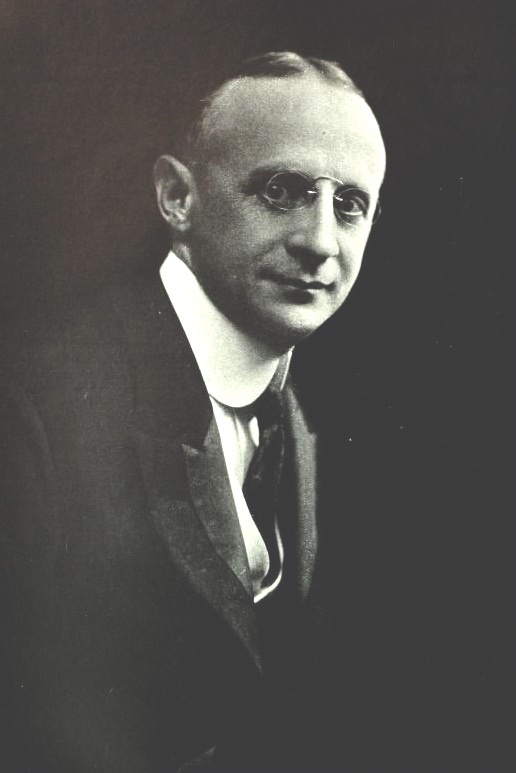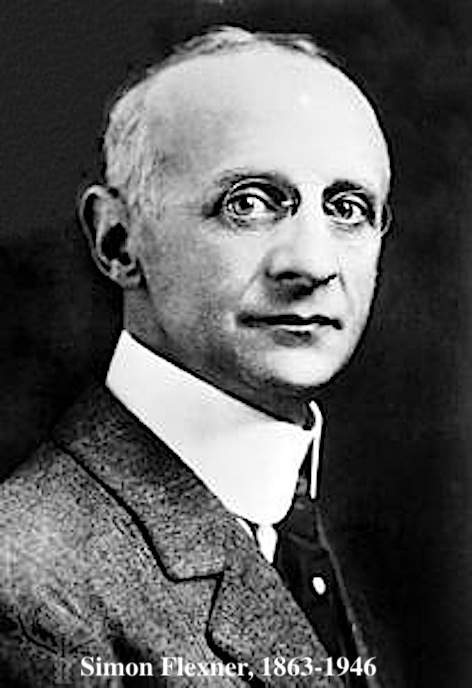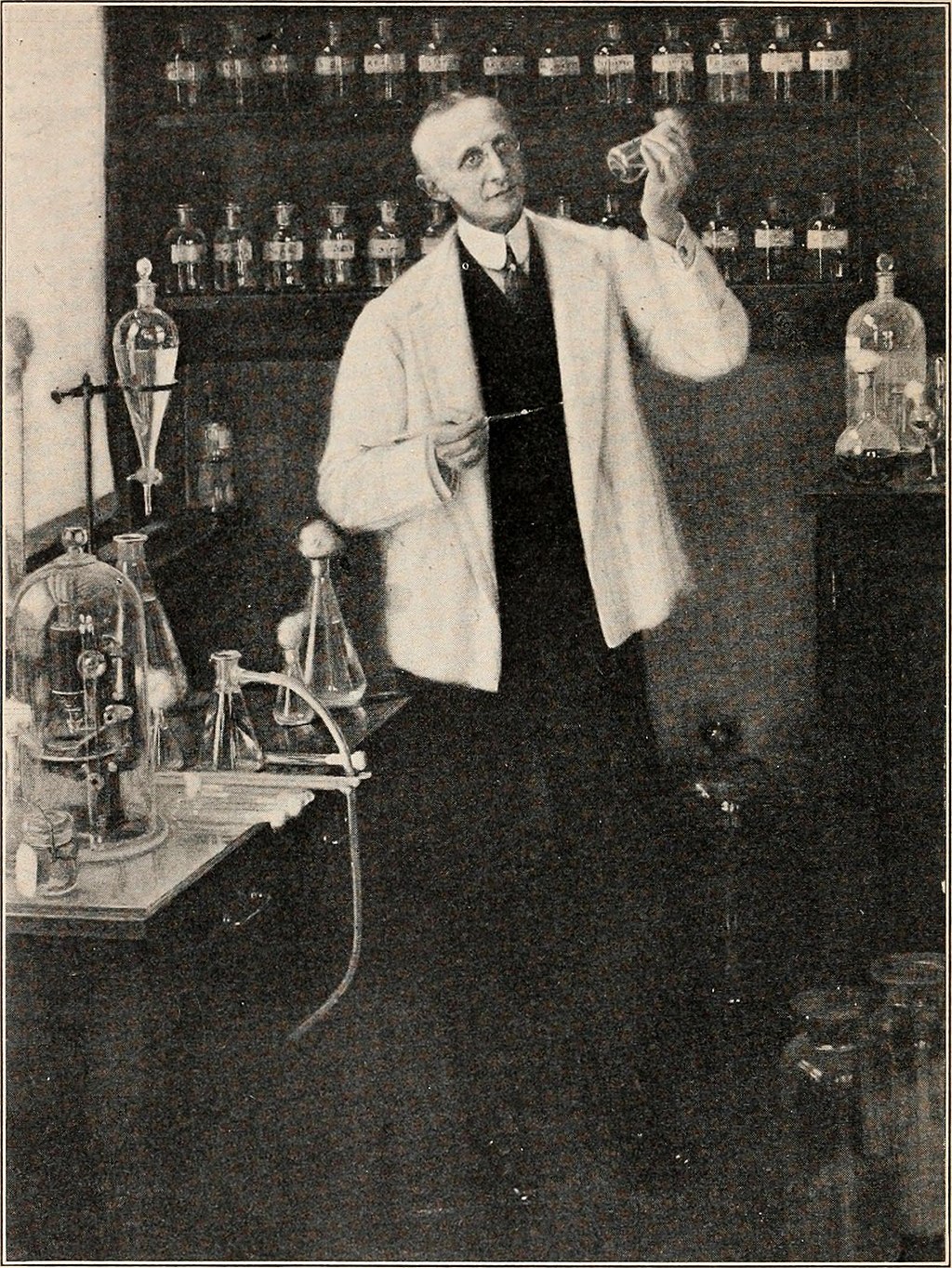
サイモン・フレクスナー
Simon Flexner, 1863-1946

☆ サイモン・フレクスナーForMemRS[1](1863年3月25日-1946年5月2日)は、医師、科学者、行政官、ペンシルベニア大学の実験病理学 教授(1899-1903年)であった。ロックフェラー医学研究所の初代所長(1901-1935)(後にロックフェラー大学として発展)、ロックフェ ラー財団の評議員を務めた。また、ジョン・D・ロックフェラー・ジュニアの友人であり、アドバイザーでもあった。 フレックスナーの最も重要な業績のひとつは、ポリオ性脊髄炎の研究と髄膜炎の血清治療の開発である。彼の研究室の助手には、後にそれぞれメモリアル病院と スローン・ケタリング研究所の所長となる野口英世とコーネリアス・ローズがいた。 さらにフレクスナーは、癌の一種である網膜芽細胞腫に特徴的な所見であるフレクスナー・ウィンターシュタイナー・ロゼットを初めて記述した。
| Simon Flexner
ForMemRS[1] (March 25, 1863 – May 2, 1946) was a physician, scientist,
administrator, and professor of experimental pathology at the
University of Pennsylvania (1899–1903). He served as the first director
of the Rockefeller Institute for Medical Research (1901–1935) (later
developed as Rockefeller University) and a trustee of the Rockefeller
Foundation. He was also a friend and adviser to John D. Rockefeller Jr. Among Flexner's most important achievements are studies into poliomyelitis and the development of serum treatment for meningitis. Among his lab assistants were Hideyo Noguchi and Cornelius Rhoads, later directors of Memorial Hospital and the Sloan-Kettering Institute, respectively. The bacteria species Shigella flexneri was named in recognition of Flexner.[2][3] In addition, Flexner was the first to describe Flexner-Wintersteiner rosettes, a characteristic finding in retinoblastoma, a type of cancer. |
サイモン・フレクスナーForMemRS[1](1863年3月25日
-1946年5月2日)は、医師、科学者、行政官、ペンシルベニア大学の実験病理学教授(1899-1903年)であった。ロックフェラー医学研究所の初
代所長(1901-1935)(後にロックフェラー大学として発展)、ロックフェラー財団の評議員を務めた。また、ジョン・D・ロックフェラー・ジュニア
の友人であり、アドバイザーでもあった。 フレックスナーの最も重要な業績のひとつは、ポリオ性脊髄炎の研究と髄膜炎の血清治療の開発である。彼の研究室の助手には、後にそれぞれメモリアル病院と スローン・ケタリング研究所の所長となる野口英世とコーネリアス・ローズがいた。 さらにフレクスナーは、癌の一種である網膜芽細胞腫に特徴的な所見であるフレクスナー・ウィンターシュタイナー・ロゼットを初めて記述した。 |
Early life and career Simon was born in Louisville, Kentucky, to Moritz (Morris) Flexner, a Jewish immigrant from Neumark, Bohemia, via several years in Strasbourg, France; and Ester from Roden, Germany.[4] He was the fourth son of seven in a large family of nine children: Jacob, Henry, and Isadore; then Simon, followed by Bernard Flexner, Abraham Flexner, and Washington. The two sisters Mary and Gertrude were the youngest. Jacob became a pharmacist and physician, Bernard became a Zionist leader, and Abraham became an educator, eventually influencing the direction of medical education in the United States.[5] Simon first gained a degree from the Louisville College of Pharmacy and worked with his brother Jacob for eight years.[5] |
生い立ちと経歴 サイモンはケンタッキー州ルイビルで、ボヘミアのノイマルクから数年間フランスのストラスブールを経てユダヤ系移民のモリッツ(モリス)・フレクスナーと ドイツのローデン出身のエステルとの間に生まれた[4]。9人家族の7人兄弟の四男として生まれた: ヤコブ、ヘンリー、イサドール、シモン、バーナード・フレクスナー、エイブラハム・フレクスナー、ワシントンと続く。姉妹のメアリーとガートルードは末っ 子だった。ヤコブは薬剤師兼医師となり、バーナードはシオニストの指導者となり、アブラハムは教育者となり、最終的には米国の医学教育の方向性に影響を与 えた[5]。 サイモンはまずルイヴィル薬科大学で学位を取得し、兄ジェイコブと共に8年間働いた[5]。 |
Medical school and career Illustration of Flexner on a 1912 cover of Popular Science Monthly He returned to college, getting his medical degree from Louisville Medical College in 1889. He did postgraduate work in pathology at Johns Hopkins University Medical School, and started teaching there. By 1899, he was a professor of pathology at the University of Pennsylvania.[5] Flexner was elected to the American Philosophical Society in 1901.[6] He taught at Penn until 1903, but was called to the Rockefeller Institute for Medical Research (later Rockefeller University), where he started serving as its first director in 1901.[7] He managed the research institute until 1935. Through this affiliation and related work, he came to know the philanthropist John D. Rockefeller, who supported research and basic medical care. In December 1907 Flexner declared in a reading of his paper on "Tendencies in Pathology" in the University of Chicago that it would be possible in the then-future for diseased human organs substitution for healthy ones by surgery—including arteries, stomach, kidneys and heart.[8] These previsions became reality in the second half of the 20th century. In 1911, Flexner was awarded the Cameron Prize for Therapeutics of the University of Edinburgh. From 1910 to 1914 he was a trustee of the Carnegie Institution.[9] |
医学部とキャリア 1912年、『月刊ポピュラー・サイエンス』の表紙に描かれたフレクスナーのイラスト。 大学に戻り、1889年にルイビル医科大学で医学の学位を取得した。その後、ジョンズ・ホプキンス大学医学部で病理学を学び、同大学で教鞭をとった。 1899年にはペンシルベニア大学の病理学教授となった[5]。 フレクスナーは1901年にアメリカ哲学協会に選出された[6]。 1903年までペンシルバニア大学で教鞭をとっていたが、ロックフェラー医学研究所(後のロックフェラー大学)に呼ばれ、1901年から初代所長を務め た。この提携と関連する仕事を通じて、彼は研究と基礎医療を支援する慈善家ジョン・D・ロックフェラーと知り合うようになった。 1907年12月、フレクスナーはシカゴ大学での「病理学の傾向」に関する論文の朗読で、動脈、胃、腎臓、心臓など、病気になった人間の臓器を手術によっ て健康な臓器と置き換えることが、当時の未来には可能になるだろうと宣言した[8]。 1911年、フレクスナーはエジンバラ大学のキャメロン治療学賞を受賞した。 1910年から1914年まで、彼はカーネギー研究所の理事を務めた[9]。 |
| Marriage and family Simon Flexner married Helen Thomas (later professor of English) and had a family. His son James Thomas Flexner became a prolific writer; one of his works was an extensive biography of George Washington. Simon Flexner died in May 1946 in New York City, from a myocardial infarction (heart attack). He was 83 years old. His papers are currently housed at the American Philosophical Society[10] and the Becker Medical Library at the Washington University School of Medicine.[11] |
結婚と家族 サイモン・フレクスナーはヘレン・トーマス(後に英語教授)と結婚し、家庭を持った。息子のジェイムズ・トーマス・フレクスナーは多作な作家となり、その 著作のひとつにジョージ・ワシントンの広範な伝記がある。 サイモン・フレクスナーは1946年5月、心筋梗塞(心臓発作)のためニューヨークで死去した。享年83歳だった。彼の論文は現在、アメリカ哲学協会 [10]とワシントン大学医学部のベッカー医学図書館に所蔵されている[11]。 |
| Abraham Flexner (1866–1959),
American educator Charles Flexner (born 1956), American physician, clinical pharmaceutical scientist, academic, author and researcher James Thomas Flexner (1908–2003), American historian and biographer |
エイブラハム・フレクスナー(1866-1959) アメリカの教育者 チャールズ・フレクスナー(1956年生まれ)アメリカの医師、臨床薬学者、学者、作家、研究者 ジェームズ・トーマス・フレクスナー(1908-2003)、アメリカの歴史家、伝記作家 |
| https://en.wikipedia.org/wiki/Simon_Flexner |
|
リ ンク
文 献
そ の他の情報
Copyleft, CC, Mitzub'ixi Quq Chi'j, 1996-2099
☆
 ☆
☆